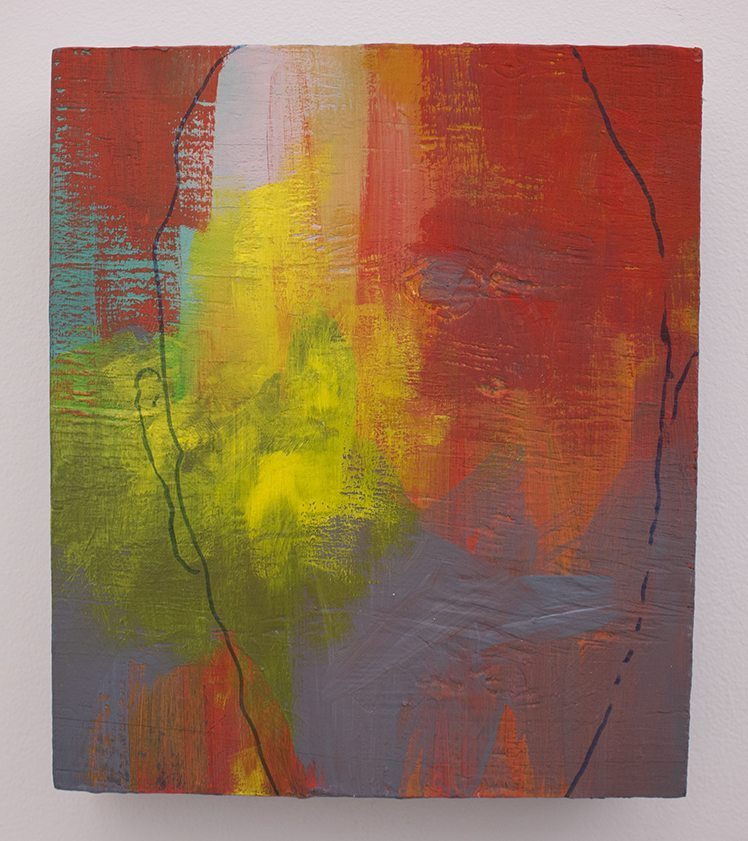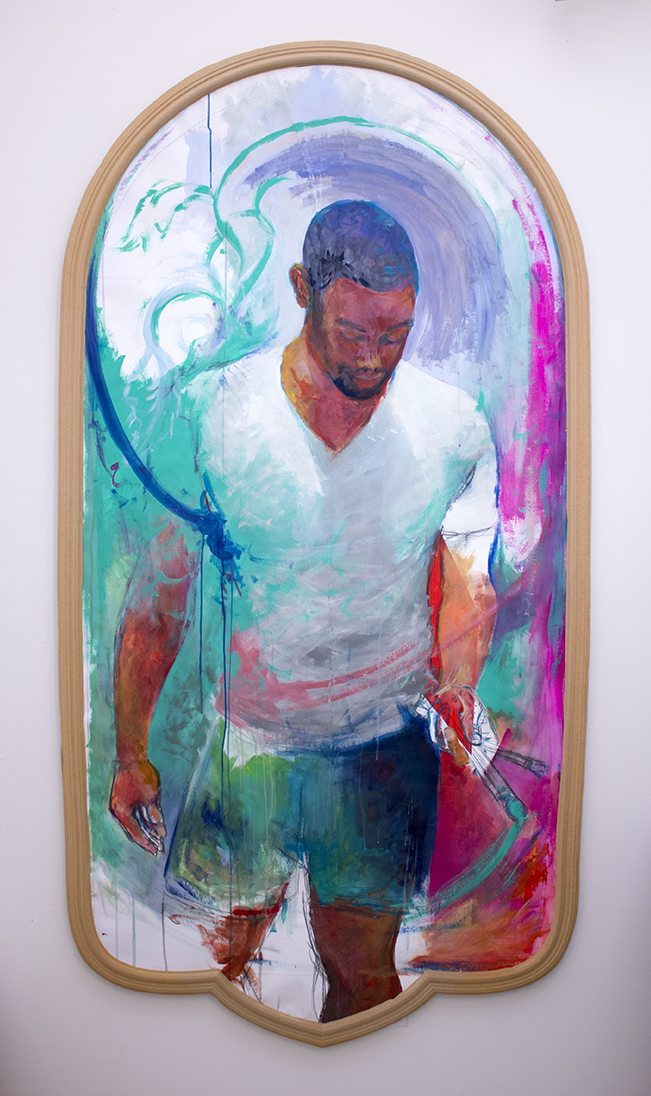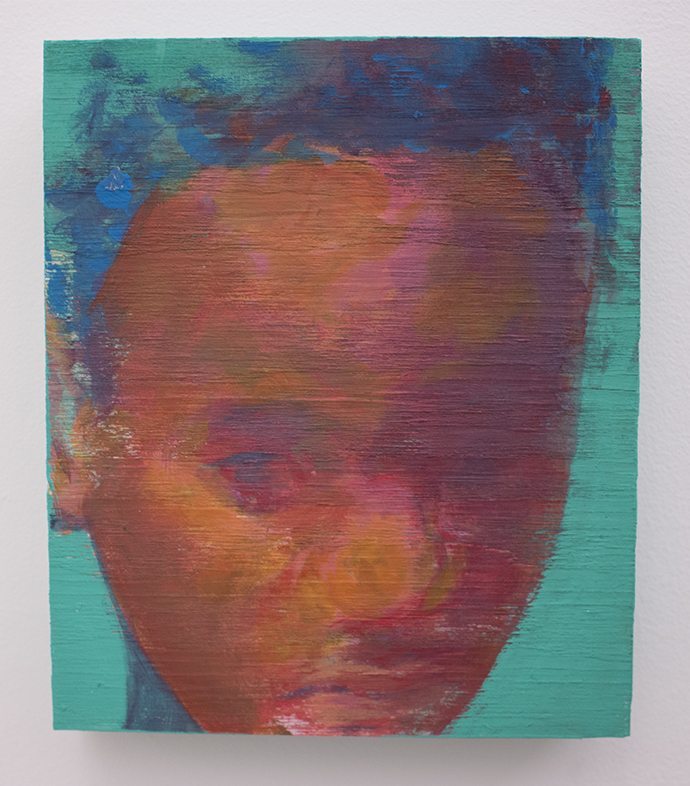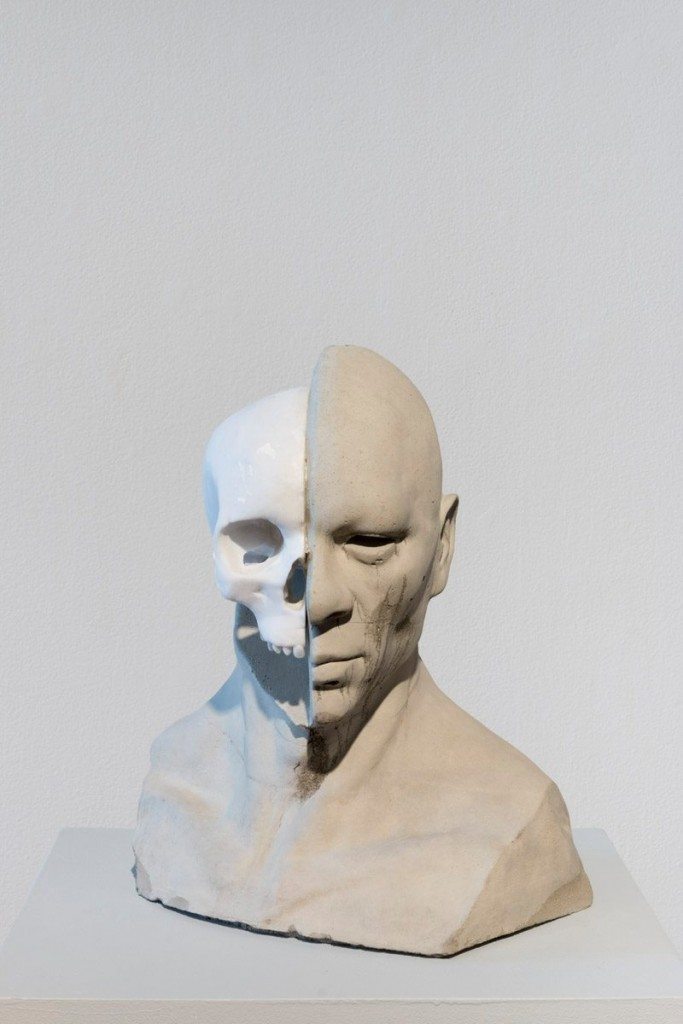
I’m not a critic. What I know is that I either like it or hate it by looking at it but I can tell that he’s developing material that is inherently his.
Gerald’s art is still developing. Influences aside, he’s come along way from the simple doodles that I’d once seen. His work uses a lot of colors, and he’s not afraid to work with different materials; this is when an illustrator or a technician gets away from copying and becomes unique. I think he’s in the best place right now, being creative, and making something out of his time, after a good career in the service as a soldier.
I called Gerald a few weeks ago and asked him if he’d like to display his artwork. I felt it was important to show off the work that veterans, and those who are still serving, do in the fields of art: photography, poetry, etc. For Spotter Up, the idea of the Whole Man is to find a way to express yourself in a constructive way. Find a way to harness the energy you’ve got and build. Some take their experiences from combat and translate that into poetry. Others create tattoos. Some have tamer experiences than others but in the end we all have to find a way to fit ourselves into a construct after serving. Gerald chose to pursue a career in art. I hope that he’s successful.
After our phone call, Gerald wrote to me, “This was a great conversation. I am very aware that my answers may come across as naivete, but I came to my conclusions based on volunteering to go to Iraq, serving in the military, and a bunch of other life experiences that involve working with people who experience life under much more difficult circumstances. My work is about people. Until we start inviting dogs and cats to galleries and asking their opinions, the subject of my work will always be about people. People fascinate me.”
My only criteria I have from my contributors is for them to be honest with their answers. It’s hard for me to describe Gerald’s work. Doing art requires the artist to not be self-conscious. The artist has to act on his faculty of perceiving, or apprehending by means of his senses, on what it is that he is ‘seeing’ and translate it so others may be provoked to some kind of emotion. Gerald’s cartoon sketches were fine for a young man, but his work now is more mature. I think at this phase of his life he’s busy in experimentation which allows him to put anything out there: filling the canvas with vivid color, trying to convey emotion, and worrying less about hesitating with brush strokes or pen lines. Hesitation is something that many writers and artists do because they lack confidence in what they are trying to express. Just like someone putting rounds downrange for the first time with a weapon. They are so reactive. They squeeze the trigger so hard and strangle what can be a masterpiece on a target or a canvas.
In one or two of Gerald’s works I think of the great Kooning’s art style, where he had this dynamic incompletion, as one writer mentioned. His forms where settling into place and finding completion. There is a tendency for some artists to smother the canvas in color, lines, and forms but those who can manipulate their ingredients around open spaces are on to something. I like Geralds self-portrait. He’s getting somewhere and I see incredible ability and progress.
Anyhow, I’m just a hack with an opinion but I hope you enjoy what you see. I do.
- Where are you from originally? I was born and raised in Atlanta, Ga. But moved to a small suburb of Atlanta my last few years of High School.
- How did you decide to enlist in the U.S. Army? I was originally planning to attend Savannah College of Art and Design, but for financial and personal reasons, I felt compelled to travel and live outside of my hometown. I always wanted to travel and the idea of living abroad was something I seriously considered. I was aware of the opportunities to travel if I joined the military, I just couldn’t predict the reality that it eventually produced for myself.
- How did enlisting in the military change you? This is a great question. My first assignment was in Paraguay as a young 19 year old fresh out of basic training and ariborne school. Everyone on my team was at least 30 years old and married, and I had never been outside Georgia. I knew spanish from high school, but I never spoke it in conversation. The experience provided the foundation for my entire military career, as well as after. It was my first experience realizing that there’s a bigger world of people out there. I am now far more sensitive to cultures and people living outside of the United States.
- How did you come about your art, were you always drawing? I was always drawing as a kid so that’s something that’s definitely part of my identity as a painter. I was more fascinated with creating my own characters rather than copying recognizable characters.
- Okay, so how do you continually tap into creativity? Is it from listening to music, meeting people, other from viewing other forms of art? This is a great question because I asked, and answered this question over the past year. My current series of work is about my biography – my identity, my culture, my past, and my present, and that all includes the people in it. My creative approach is analogous to reading a book. Each work is a chapter of my life. So I am fascinated in telling that story because I think it’s an interesting story and it’s a perspective I haven’t seen in the art world.
- What is a song or band that has really moved you? Outkast and Lynyrd Skynyrd.
- Clearly you are inspired by those who serve. How do you choose your subject matter? There’s a very intimate admiration I have for veterans. Especially those who are close to me. Regardless of politics, I love the people who serve. I am working on exploring the veteran identity in my work. But it’s difficult for me to arbitrarily speak about those who serve, because I can’t put into words the experience of being a service member. I think it’s something that is experienced and I am trying to figure out how do I communicate selfless service to a population that has been distracted with reality television?
- What three words best describe your personality and how does it translate into your art? People have described me as sincere, thoughtful and considerate. I think I am selfless, intuitive, and mercurial – (Mercutio is one of my favorite characters..)
- What three words best describe your body of work? Philosophical, spiritual, emotive
- Who are some of your favorite visual artists? John Singer Sargent, Henry Ossawa Tanner, Lisa Yuskavage, Jenny Saville, Raphael
- What’s the last movie you saw of note? The Theory of Everything
- What is the most important lesson you have learned in life so far? “it” is all relative, It = our life experiences.
- Does your faith help you create? I currently think the idea of faith is very human and that fascinates me.
- What motivates you? Children motivate me with their authenticity, energy, and curiosity.
- What is the most beautiful thing you have ever seen? That’s tough, Nature has a way of introducing the sublime. I was on the island of Capri last year, and on the boat, I could see the blue water, the mountains, and the land. There is something surreal about nature that is powerful.
- What’s your best talent? I listen very very well.
- What’s your biggest weakness? My temper
- Do you ever find yourself in a creative dry spell? If so, what do you do to find yourself again and create new work? Two years ago, I was studying graphic design and I could not find creative solutions for the homework assignments. It was terrible. I actually cried to my friend because I found myself losing passion to create art. But then, I quit graphic design and switched to painting. I like making things and I realized that if something stunts my creative process, it’s not necessary for my growth as an artist. So when I am in a creative dry spell, I try to eliminate things in my life that are distracting me. If tomorrow I wake up and decide that picking up garbage will help me creatively, that’s what I will do. For me, it’s complete satisfaction with myself and my growth and not what society says I need to do to be successful. That was a little vague, but I am more than willing to answer a follow up question to that.
- Talk a little bit about your creative process – from getting the idea to the finished “product” of the image? I was following an artist I really liked at one point and found out he graduated from my school. When I met him, I asked him how he could continue to produce work – he basically told me to look at my journal and the themes and ideas will present himself to me. My journal and my biography is my work. I can never complete a book of my life if I’m still living it so that’s what currently motivates me. The ABC’s of my process are I have an experience, I write it down, I reflect and meditate on it, I write notes and research, then I forget it all over a few drinks, then create. But I never paint under the influence. I can only paint sober.
- How do you challenge yourself in your work? I am currently exploring natural pigments from earth minerals, as well as using flashe, which is a flat vinyl paint that is really difficult to work with on different surfaces.
- Best compliment you ever got? It wasn’t exactly a compliment, but I had a painting instructor tell me “You’re not Michelangelo…”
- If you had the chance to say anything to the world, what would it be? Difference is a good thing.
- What’s your advice to other creative folks? Spend time with people who think opposite of you, read, write, meditate, exercise, debate, argue, laugh, have sex and fail.
- What’s one professional or creative thing on your bucket list? I want to replace the concept of race with culture. Culture is the only thing that truly distinguishes us. Difference is a good thing.
- What do you feel are the recurring themes in your images? What is the world you are trying to create or magnify for your audience? What do you hope your images make them feel? I want the audience to come to their own conclusions, I just want to introduce an idea and perspective that’s authentic and unique and the audience can make their own assumptions based on what they see.
Thank You Gerald.












